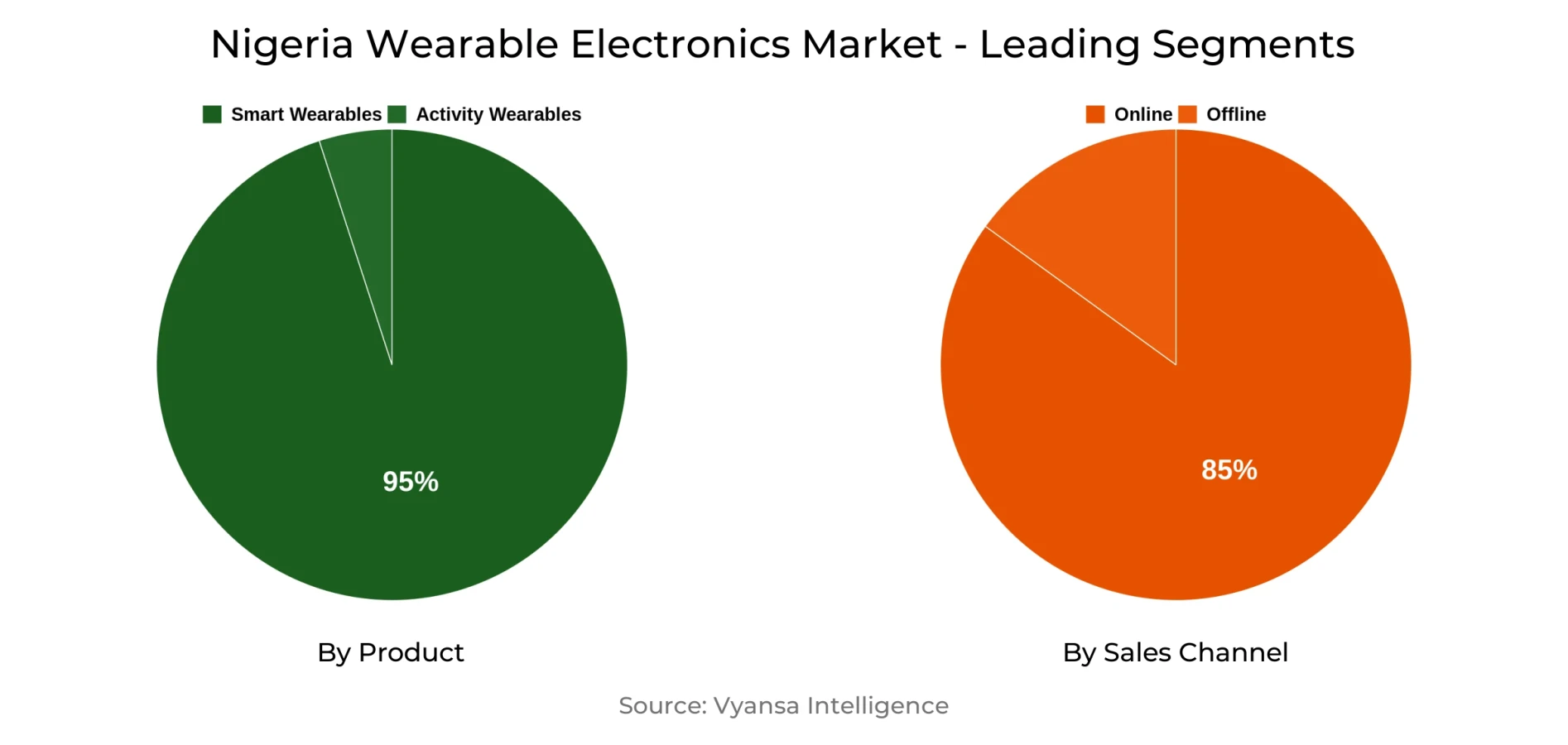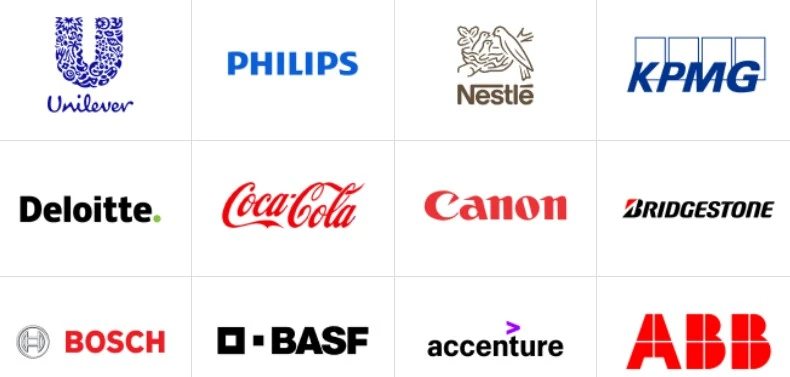Nigeria Wearable Electronics Market Report: Trends, Growth and Forecast (2025-2030)
By Product (Activity Wearables, Smart Wearables), By Application (Healthcare, Entertainment, Industrial, Others), By Sales Channel (Offline, Online)
- FMCG
- Dec 2025
- VI0069
- 122
-




Nigeria Wearable Electronics Market Statistics, 2025
- Market Size Statistics
- Wearable Electronics in Nigeria is estimated at $ 3.45 Million.
- The market size is expected to grow to $ 9.75 Million by 2030.
- Market to register a CAGR of around 18.9% during 2025-30.
- Product Shares
- Smart Wearables grabbed market share of 95%.
- Smart Wearables to witness a volume CAGR of around 20.09%.
- Competition
- More than 5 companies are actively engaged in producing Wearable Electronics in Nigeria.
- Top 5 companies acquired 45% of the market share.
- Huawei Technologies Co Ltd, Garmin Southern Africa (Pty) Ltd, Alphabet Inc., Oraimo Technology Ltd, Xiaomi Corp etc., are few of the top companies.
- Sales Channel
- Retail E-Commerce grabbed 85% of the market.
Nigeria Wearable Electronics Market Outlook
The wearable electronics market in Nigeria is likely to see consistent growth between 2025 and 2030, based primarily on the health and wellness trend. As consumers become increasingly concerned with tracking their wellbeing and health, intelligent wearables will remain on an upward trend. With increased economic stability and rising disposable incomes, demand will increase for these health-driven devices. The market will witness a shift in consumer demand away from bare-bones activity trackers to high-functioning smart wearables that come in different designs and price points to appeal to broader audiences, even those looking for both form and function.
Inexpensive alternative brands, specifically generic Chinese producers, will be key to the growth of adoption. These brands provide intelligent wearables with comparable features to high-end devices but at affordable prices, and these are extremely appealing to price-conscious Nigerian consumers. With the loosening of economic pressures, more consumers will have access to afford these, thus driving penetration among various age and income segments. These brands will keep pressuring premium players by providing competitive prices and robust marketing strategies.
Oraimo Technology Ltd will continue to dominate the Nigerian market for wearable electronics. The company's mid-range price point, aggressive promotional offers, and cutting-edge product features have fostered strong consumer affection. Although premium players like Samsung and Apple are still in the market, their growth will be slower than that of value players like Oraimo, Xiaomi, and other Chinese players.
E-commerce will continue to be one of the leading growth drivers for the market of wearable electronics. With comfort access to an array of products, online-only offers, and growing tech-wiseness among young Nigerians, online channels will continue to drive the rising demand. The ease of home delivery and dependency on online reviews will also serve to drive online sales of smart wearables in the nation.

Nigeria Wearable Electronics Market Trend
The increasing emphasis on wellness and health is predicted to drive demand for smart wearables in Nigeria from 2025 to 2030. As consumers increasingly turn to tracking their health data to enhance their health, smart wearables become more in demand. With the economy on the path of recovery and disposable incomes on the increase, even more individuals will invest in health-oriented devices. Amongst consumer electronics, wearables will do the best, with consumers migrating from simple activity wearables and activity watches to smarter wearables.
Smart wearables are likely to appeal to a broader base of consumers with a range of models at various price points. Moreover, a greater emphasis on design and the introduction of slimline products will appeal to aspirational Nigerians. While consumers appreciate the capabilities of smart wearables, they also desire designs that look like traditional watches so that they can double up as both technology devices and fashion accessories.
Nigeria Wearable Electronics Market Opportunity
Low-cost Chinese generic brands will be a major driver of growth of wearable electronics in Nigeria in 2025-30. With economic difficulties slowly subsiding, customers will increasingly have excess funds to invest in affordable smart wearables. These brands provide functions similar to those of high-end devices, hence presenting an appealing proposition for price-conscious consumers—a significant majority in Nigeria. Their growing availability will most likely drive adoption, particularly among young adults and athletes.
The increasing popularity of these low-cost wearables will also increase competition in the market. Their price-cutting strategies could compel high-end brands to change their pricing structures, which would ultimately benefit consumers. Additionally, the high online penetration and aggressive marketing strategies of these generic brands will also accelerate their growth, allowing advanced health and fitness tracking technology to reach more consumers in Nigeria.
| Report Coverage | Details |
|---|---|
| Market Forecast | 2025-30 |
| USD Value 2024 | $ 3.45 Million |
| USD Value 2030 | $ 9.75 Million |
| CAGR 2025-2030 | 18.9% |
| Largest Category | Smart Wearables segment leads with 95% market share |
| Top Trends | Health-Driven Demand to Accelerate Smart Wearables Growth |
| Top Opportunities | Rising Penetration of Affordable Generic Brands |
| Key Players | Huawei Technologies Co Ltd, Garmin Southern Africa (Pty) Ltd, Alphabet Inc., Oraimo Technology Ltd, Xiaomi Corp, Fitbit Inc, Apple Inc, Samsung Electronics SA (Pty) Ltd and Others. |
Nigeria Wearable Electronics Market Segmentation Analysis

Retail E-commerce. This is largely because of the large array of wearable products found on the internet. In contrast to most consumer electronics in Nigeria, which are widely purchased in brick-and-mortar shops, wearable electronics are tiny and simple to deliver. This renders home delivery more practical and cost-efficient. Most exclusive deals are also made available over the internet, further enticing buyers to this platform.
Moreover, e-commerce is especially favored by young and technologically aware customers. They tend to reside in locations with suitable internet connectivity and like reading online reviews before buying. Payment on delivery and speedy doorstep delivery are also their favorite features. With these variables being considered, the e-commerce channel will remain a major driver for wearable electronics growth in Nigeria over the forecast period.
Top Companies in Nigeria Wearable Electronics Market
The top companies operating in the market include Huawei Technologies Co Ltd, Garmin Southern Africa (Pty) Ltd, Alphabet Inc., Oraimo Technology Ltd, Xiaomi Corp, Fitbit Inc, Apple Inc, Samsung Electronics SA (Pty) Ltd, etc., are the top players operating in the Nigeria Wearable Electronics Market.
Frequently Asked Questions
Related Report
1. Market Segmentation
1.1. Research Scope
1.2. Research Methodology
1.3. Definitions and Assumptions
2. Executive Summary
3. Nigeria Wearable Electronics Market Policies, Regulations, and Standards
4. Nigeria Wearable Electronics Market Dynamics
4.1. Growth Factors
4.2. Challenges
4.3. Trends
4.4. Opportunities
5. Nigeria Wearable Electronics Market Statistics, 2020-2030F
5.1. Market Size & Growth Outlook
5.1.1.By Revenues in US$ Million
5.1.2.By Unit Sold (Thousand Units)
5.2. Market Segmentation & Growth Outlook
5.2.1.By Product
5.2.1.1. Activity Wearables- Market Insights and Forecast 2020-2030, USD Million
5.2.1.1.1. Activity Bands- Market Insights and Forecast 2020-2030, USD Million
5.2.1.1.2. Activity Watch- Market Insights and Forecast 2020-2030, USD Million
5.2.1.1.2.1. Analogue- Market Insights and Forecast 2020-2030, USD Million
5.2.1.1.2.2. Digital- Market Insights and Forecast 2020-2030, USD Million
5.2.1.2. Smart Wearables- Market Insights and Forecast 2020-2030, USD Million
5.2.1.2.1. Eye Wear- Market Insights and Forecast 2020-2030, USD Million
5.2.1.2.2. Body Wear- Market Insights and Forecast 2020-2030, USD Million
5.2.2.By Application
5.2.2.1. Healthcare- Market Insights and Forecast 2020-2030, USD Million
5.2.2.2. Entertainment- Market Insights and Forecast 2020-2030, USD Million
5.2.2.3. Industrial- Market Insights and Forecast 2020-2030, USD Million
5.2.2.4. Others- Market Insights and Forecast 2020-2030, USD Million
5.2.3.By Sales Channel
5.2.3.1. Offline- Market Insights and Forecast 2020-2030, USD Million
5.2.3.2. Online- Market Insights and Forecast 2020-2030, USD Million
5.2.4.By Competitors
5.2.4.1. Competition Characteristics
5.2.4.2. Market Share & Analysis
6. Nigeria Activity Wearable Electronics Market Statistics, 2020-2030F
6.1. Market Size & Growth Outlook
6.1.1.By Revenues in US$ Million
6.1.2.By Unit Sold (Thousand Units)
6.2. Market Segmentation & Growth Outlook
6.2.1.By Product- Market Insights and Forecast 2020-2030, USD Million
6.2.2.By Application- Market Insights and Forecast 2020-2030, USD Million
6.2.3.By Sales Channel- Market Insights and Forecast 2020-2030, USD Million
7. Nigeria Smart Wearable Electronics Market Statistics, 2020-2030F
7.1. Market Size & Growth Outlook
7.1.1.By Revenues in US$ Million
7.1.2.By Unit Sold (Thousand Units)
7.2. Market Segmentation & Growth Outlook
7.2.1.By Product- Market Insights and Forecast 2020-2030, USD Million
7.2.2.By Application- Market Insights and Forecast 2020-2030, USD Million
7.2.3.By Sales Channel- Market Insights and Forecast 2020-2030, USD Million
8. Competitive Outlook
8.1. Company Profiles
8.1.1.Oraimo Technology Ltd
8.1.1.1. Business Description
8.1.1.2. Product Portfolio
8.1.1.3. Collaborations & Alliances
8.1.1.4. Recent Developments
8.1.1.5. Financial Details
8.1.1.6. Others
8.1.2.Xiaomi Corp
8.1.2.1. Business Description
8.1.2.2. Product Portfolio
8.1.2.3. Collaborations & Alliances
8.1.2.4. Recent Developments
8.1.2.5. Financial Details
8.1.2.6. Others
8.1.3.Fitbit Inc
8.1.3.1. Business Description
8.1.3.2. Product Portfolio
8.1.3.3. Collaborations & Alliances
8.1.3.4. Recent Developments
8.1.3.5. Financial Details
8.1.3.6. Others
8.1.4.Apple Inc
8.1.4.1. Business Description
8.1.4.2. Product Portfolio
8.1.4.3. Collaborations & Alliances
8.1.4.4. Recent Developments
8.1.4.5. Financial Details
8.1.4.6. Others
8.1.5.Samsung Electronics SA (Pty) Ltd
8.1.5.1. Business Description
8.1.5.2. Product Portfolio
8.1.5.3. Collaborations & Alliances
8.1.5.4. Recent Developments
8.1.5.5. Financial Details
8.1.5.6. Others
8.1.6.Huawei Technologies Co Ltd
8.1.6.1. Business Description
8.1.6.2. Product Portfolio
8.1.6.3. Collaborations & Alliances
8.1.6.4. Recent Developments
8.1.6.5. Financial Details
8.1.6.6. Others
8.1.7.Garmin Southern Africa (Pty) Ltd
8.1.7.1. Business Description
8.1.7.2. Product Portfolio
8.1.7.3. Collaborations & Alliances
8.1.7.4. Recent Developments
8.1.7.5. Financial Details
8.1.7.6. Others
8.1.8.Alphabet Inc.
8.1.8.1. Business Description
8.1.8.2. Product Portfolio
8.1.8.3. Collaborations & Alliances
8.1.8.4. Recent Developments
8.1.8.5. Financial Details
8.1.8.6. Others
8.1.9.Company 9
8.1.9.1. Business Description
8.1.9.2. Product Portfolio
8.1.9.3. Collaborations & Alliances
8.1.9.4. Recent Developments
8.1.9.5. Financial Details
8.1.9.6. Others
8.1.10. Company 10
8.1.10.1. Business Description
8.1.10.2. Product Portfolio
8.1.10.3. Collaborations & Alliances
8.1.10.4. Recent Developments
8.1.10.5. Financial Details
8.1.10.6. Others
9. Disclaimer
| Segment | Sub-Segment |
|---|---|
| By Product |
|
| By Application |
|
| By Sales Channel |
|
Research Methodology
This study followed a structured approach comprising four key phases to assess the size and scope of the electro-oxidation market. The process began with thorough secondary research to collect data on the target market, related markets, and broader industry context. These findings, along with preliminary assumptions and estimates, were then validated through extensive primary research involving industry experts from across the value chain. To calculate the overall market size, both top-down and bottom-up methodologies were employed. Finally, market segmentation and data triangulation techniques were applied to refine and validate segment-level estimations.
Secondary Research
The secondary research phase involved gathering data from a wide range of credible and published sources. This step helped in identifying industry trends, defining market segmentation, and understanding the market landscape and value chain.
Sources consulted during this phase included:
- Company annual reports, investor presentations, and press releases
- Industry white papers and certified publications
- Trade directories and market-recognized databases
- Articles from authoritative authors and reputable journals
- Gold and silver standard websites
Secondary research was critical in mapping out the industry's value chain and monetary flow, identifying key market segments, understanding regional variations, and tracking significant industry developments.
Other key sources:
- Financial disclosures
- Industry associations and trade bodies
- News outlets and business magazines
- Academic journals and research studies
- Paid industry databases
Primary Research
To validate secondary data and gain deeper market insights, primary research was conducted with key stakeholders across both the supply and demand sides of the market.
On the demand side, participants included decision-makers and influencers from end-user industries—such as CIOs, CTOs, and CSOs—who provided first-hand perspectives on market needs, product usage, and future expectations.
On the supply side, interviews were conducted with manufacturers, industry associations, and institutional participants to gather insights into current offerings, product pipelines, and market challenges.
Primary interviews provided critical inputs such as:
- Market size and revenue data
- Product and service breakdowns
- Market forecasts
- Regional and application-specific trends
Stakeholders consulted included:
- Leading OEM and solution providers
- Channel and distribution partners
- End users across various applications
- Independent consultants and industry specialists
Market Size Estimation and Data Triangulation
- Identifying Key Market Participants (Secondary Research)
- Goal: To identify the major players or companies in the target market. This typically involves using publicly available data sources such as industry reports, market research publications, and financial statements of companies.
- Tools: Reports from firms like Gartner, Forrester, Euromonitor, Statista, IBISWorld, and others. Public financial statements, news articles, and press releases from top market players.
- Extracting Earnings of Key Market Participants
- Goal: To estimate the earnings generated from the product or service being analyzed. This step helps in understanding the revenue potential of each market player in a specific geography.
- Methods: Earnings data can be gathered from:
- Publicly available financial reports (for listed companies).
- Interviews and primary data sources from professionals, such as Directors, VPs, SVPs, etc. This is especially useful for understanding more nuanced, internal data that isn't publicly disclosed.
- Annual reports and investor presentations of key players.
- Data Collation and Development of a Relevant Data Model
- Goal: To collate inputs from both primary and secondary sources into a structured, data-driven model for market estimation. This model will incorporate key market KPIs and any independent variables relevant to the market.
- Key KPIs: These could include:
- Market size, growth rate, and demand drivers.
- Industry-specific metrics like market share, average revenue per customer (ARPC), or average deal size.
- External variables, such as economic growth rates, inflation rates, or commodity prices, that could affect the market.
- Data Modeling: Based on this data, the market forecasts are developed for the next 5 years. A combination of trend analysis, scenario modeling, and statistical regression might be used to generate projections.
- Scenario Analysis
- Goal: To test different assumptions and validate how sensitive the market is to changes in key variables (e.g., market demand, regulatory changes, technological disruptions).
- Types of Scenarios:
- Base Case: Based on current assumptions and historical data.
- Best-Case Scenario: Assuming favorable market conditions, regulatory environments, and technological advancements.
- Worst-Case Scenario: Accounting for adverse factors, such as economic downturns, stricter regulations, or unexpected disruptions.
Partnering With Industry Leaders to Drive Growth
Our mission is to deliver intelligence that matters. By combining data, analysis, and industry expertise, we enable organizations to make smarter, faster, and more impactful decisions. Whether it’s a Fortune 500 company or a high-growth startup, businesses trust us to provide clarity in an ever-evolving marketplace.






